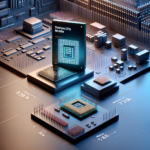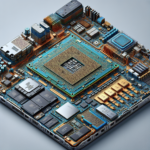The Role of CPUs in Real-Time Systems

The Role of CPUs in Real-Time Systems
Real-time systems are an integral part of modern technology, playing a crucial role in various applications ranging from industrial automation to medical devices and aerospace systems. At the heart of these systems lies the Central Processing Unit (CPU), which is responsible for executing instructions and managing tasks in a timely manner. This article delves into the role of CPUs in real-time systems, exploring their importance, functionality, and the challenges they face.
Understanding Real-Time Systems
What Are Real-Time Systems?
Real-time systems are computing systems that must respond to inputs or events within a strict time constraint. Unlike general-purpose systems, where performance is measured by throughput and efficiency, real-time systems prioritize timely and predictable responses. These systems are categorized into two types:
- Hard Real-Time Systems: These systems have stringent timing constraints, and failure to meet these deadlines can result in catastrophic consequences. Examples include pacemakers, automotive airbag systems, and industrial control systems.
- Soft Real-Time Systems: These systems have more lenient timing constraints, where missing a deadline may degrade performance but does not lead to catastrophic failure. Examples include video streaming, online gaming, and multimedia applications.
Key Characteristics of Real-Time Systems
Real-time systems exhibit several key characteristics that distinguish them from other computing systems:
- Determinism: The ability to predict the system’s behavior and response times accurately.
- Reliability: The system must consistently perform its intended functions under specified conditions.
- Low Latency: The system must respond to events with minimal delay.
- High Availability: The system must be operational and accessible when needed.
The Role of CPUs in Real-Time Systems
CPU Architecture and Real-Time Systems
The architecture of a CPU plays a significant role in determining its suitability for real-time systems. Key architectural features that impact real-time performance include:
- Instruction Set Architecture (ISA): The ISA defines the set of instructions the CPU can execute. A well-designed ISA can optimize performance and reduce latency in real-time applications.
- Cache Memory: While cache memory can improve performance by reducing access times to frequently used data, it can also introduce unpredictability in real-time systems. Real-time CPUs often use deterministic cache policies or avoid caches altogether.
- Pipelining: Pipelining allows multiple instructions to be processed simultaneously, improving throughput. However, it can also introduce timing variability, which must be carefully managed in real-time systems.
- Interrupt Handling: Efficient interrupt handling is crucial for real-time systems, as it allows the CPU to quickly respond to external events.
Scheduling and Task Management
In real-time systems, the CPU must manage multiple tasks with varying priorities and deadlines. Effective scheduling algorithms are essential to ensure that high-priority tasks are executed on time. Common scheduling algorithms used in real-time systems include:
- Rate Monotonic Scheduling (RMS): A fixed-priority algorithm where tasks with shorter periods are given higher priority.
- Earliest Deadline First (EDF): A dynamic priority algorithm where tasks with the earliest deadlines are given higher priority.
- Least Laxity First (LLF): A dynamic priority algorithm where tasks with the least slack time (time until deadline minus remaining execution time) are given higher priority.
These algorithms help ensure that critical tasks are completed within their deadlines, maintaining the system’s overall reliability and performance.
Real-Time Operating Systems (RTOS)
A Real-Time Operating System (RTOS) is a specialized operating system designed to manage hardware resources and execute tasks in a real-time environment. The RTOS plays a crucial role in coordinating the CPU’s activities, providing features such as:
- Task Scheduling: Efficiently managing task execution based on priority and deadlines.
- Inter-Task Communication: Facilitating communication and synchronization between tasks.
- Resource Management: Allocating and managing hardware resources such as memory and I/O devices.
- Interrupt Handling: Providing mechanisms for handling interrupts and ensuring timely responses to external events.
Popular RTOS examples include FreeRTOS, VxWorks, and QNX, each offering unique features and capabilities tailored to different real-time applications.
Challenges in Real-Time Systems
Predictability and Determinism
One of the primary challenges in real-time systems is ensuring predictability and determinism. The CPU must execute tasks within specified time constraints, and any variability in execution times can lead to missed deadlines. Factors that can impact predictability include:
- Cache Misses: Unpredictable cache behavior can introduce variability in memory access times.
- Interrupt Latency: Delays in handling interrupts can affect the timely execution of critical tasks.
- Context Switching: Frequent context switches between tasks can introduce overhead and impact performance.
Resource Constraints
Real-time systems often operate in resource-constrained environments, where limited memory, processing power, and energy must be carefully managed. The CPU must efficiently allocate resources to ensure that all tasks meet their deadlines without compromising system performance.
Concurrency and Synchronization
Real-time systems frequently involve concurrent tasks that must be synchronized to avoid conflicts and ensure data consistency. The CPU must provide mechanisms for inter-task communication and synchronization, such as semaphores, mutexes, and message queues, to manage concurrency effectively.
Fault Tolerance and Reliability
Real-time systems must be highly reliable and capable of handling faults gracefully. The CPU must support fault-tolerant mechanisms such as redundancy, error detection and correction, and graceful degradation to ensure continuous operation even in the presence of hardware or software failures.
Advancements in CPU Technology for Real-Time Systems
Multi-Core and Many-Core Processors
The advent of multi-core and many-core processors has significantly impacted real-time systems. These processors offer parallelism, allowing multiple tasks to be executed simultaneously, improving overall system performance. However, managing task scheduling and synchronization across multiple cores introduces new challenges that must be addressed to maintain real-time guarantees.
Hardware Accelerators
Hardware accelerators, such as Graphics Processing Units (GPUs) and Field-Programmable Gate Arrays (FPGAs), can offload specific tasks from the CPU, enhancing performance and reducing latency. These accelerators are increasingly being integrated into real-time systems to handle computationally intensive tasks such as image processing, machine learning, and cryptography.
Energy-Efficient CPUs
Energy efficiency is a critical consideration in many real-time systems, particularly in battery-powered devices such as medical implants and IoT sensors. Advances in CPU design, such as dynamic voltage and frequency scaling (DVFS) and power gating, enable real-time systems to optimize energy consumption while maintaining performance and meeting timing constraints.
FAQ
What is the difference between a real-time system and a general-purpose system?
A real-time system prioritizes timely and predictable responses to events, with strict timing constraints. In contrast, a general-purpose system focuses on overall performance and efficiency, without stringent timing requirements.
Why is predictability important in real-time systems?
Predictability ensures that tasks are executed within specified time constraints, preventing missed deadlines and potential system failures. It is crucial for maintaining the reliability and performance of real-time systems.
What are some common scheduling algorithms used in real-time systems?
Common scheduling algorithms include Rate Monotonic Scheduling (RMS), Earliest Deadline First (EDF), and Least Laxity First (LLF). These algorithms help prioritize tasks based on their deadlines and execution requirements.
How do multi-core processors impact real-time systems?
Multi-core processors offer parallelism, allowing multiple tasks to be executed simultaneously, improving overall system performance. However, they also introduce challenges in task scheduling and synchronization that must be managed to maintain real-time guarantees.
What role do hardware accelerators play in real-time systems?
Hardware accelerators, such as GPUs and FPGAs, offload specific tasks from the CPU, enhancing performance and reducing latency. They are increasingly used in real-time systems to handle computationally intensive tasks.
Conclusion
The role of CPUs in real-time systems is multifaceted and critical to the successful operation of these systems. From managing task scheduling and synchronization to ensuring predictability and reliability, the CPU is at the heart of real-time computing. As technology continues to advance, innovations in CPU design, multi-core processing, and hardware acceleration will further enhance the capabilities of real-time systems, enabling them to meet the ever-growing demands of modern applications.




